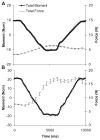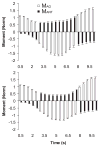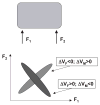Age-related changes in multifinger synergies in accurate moment of force production tasks
- PMID: 17204576
- PMCID: PMC2821089
- DOI: 10.1152/japplphysiol.00966.2006
Age-related changes in multifinger synergies in accurate moment of force production tasks
Abstract
The purpose of this investigation was to document and quantify age-related differences in the coordination of fingers during a task that required production of an accurate time profile of the total moment of force by the four fingers of a hand. We hypothesized that elderly subjects would show a decreased ability to stabilize a time profile of the total moment of force, leading to larger indexes of moment variability compared with young subjects. The subjects followed a trapezoidal template on a computer screen by producing a time profile of the total moment of force while pressing down on force sensors with the four fingers of the right (dominant) hand. To quantify synergies, we used the framework of the uncontrolled manifold hypothesis. The elderly subjects produced larger total force, larger variance of both total force and total moment of force, and larger involvement of fingers that produced moment of force against the required moment direction (antagonist moment). This was particularly prominent during supination efforts. Young subjects showed covariation of commands to fingers across trials that stabilized the moment of total force (moment-stabilizing synergy), while elderly subjects failed to do so. Both subject groups showed similar indexes of covariation of commands to the fingers that stabilized the time profile of the total force. The lack of moment-stabilizing synergies may be causally related to the documented impairment of hand function with age.
Figures









References
-
- Arbib MA, Iberall T, Lyons D. Coordinated control programs for movements of the hand. In: Goodwin AW, Darian-Smith I, editors. Hand Function and the Neocortex (Experimental Brain Research Supplement) Berlin: Springer-Verlag; 1985.
-
- Boatright JR, Kiebzak GM, O’Neil DM, Peindl RD. Measurement of thumb abduction strength: normative data and a comparison with grip and pinch strength. J Hand Surg [Am] 1997;22:843–848. - PubMed
-
- Bock O. Components of sensorimotor adaptation in young and elderly subjects. Exp Brain Res. 2005;160:259–263. - PubMed
-
- Buchanan TS, Rovai GP, Rymer WZ. Strategies for muscle activation during isometric torque generation at the human elbow. J Neurophysiol. 1989;62:1201–1212. - PubMed
Publication types
MeSH terms
Grants and funding
LinkOut - more resources
Full Text Sources
Medical

